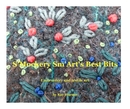Sharon B posted a link to the work of Constance Howard
here, and Elizabeth of
Quieter Moments asked for any information on her books. Many years ago I bought two of her books in a second-hand shop and they whetted my appetite for more and were partly responsible for me signing up for City & Guilds.
Here's the cover of the first one:

Published and reprinted in 1979 by Batsford. ISBN 0 7134 1005 1
Here's the 'publisher's blurb'.
Stitches have become an international language. They have been handed down from generation to generation, family by family, the repertoire being added to by travellers returning from all parts of the world. New stitches continue to be invented and these pages contain a number of new ones worked out by Constance Howard who has been asked by so many of her students to prepare such a book so that they, and a much wider audience, may be able to enjoy further experiments on their own. The idea of this book therefore is to show some of the enormous scope of stitches, their versatility, the fascinating textures and patterns obtainable with them, and the variety that is possible in working a stitch in different threads, changing its scale and spacing, working carefully, working freely, combining stitches to make new ones or altering the angle of the stitch.and for Elizabeth, here's a double page spread on buttonhole stitch:
 (click on photo for bigger image)
(click on photo for bigger image)I had never seen anything like this before!
Here's a picture of the cover of the other book I have:

It's another Batsford book published in 1976. ISBN 0 7134 3125 3
Here's a list of the contents:

Because the book was published in the 70's, most of the illustrations were in black and white with a few colour plates. Here are a couple of double page spreads to whet YOUR appetite!

 (click on photos for bigger image)
(click on photos for bigger image)When I bought these books in the late 70s early 80s I had never seen work like this before - it was a relevation!
To my mind, Constance Howard was a major influence in contemporary creative embroidery. She fits in with Sharon's TIF challenge in that many, many people admire her work, both in execution and in teaching, and she had green hair!
There is nice tribute to Constance Howard on the Embroiderer's Guild site
here
**Update**
a link to two pieces of work by Constance Howard at
Embroidery
a link to 'The Country Wife' at the
National Needlework Archive
and a close-up of 'The Country Wife' at
Embroidery


































